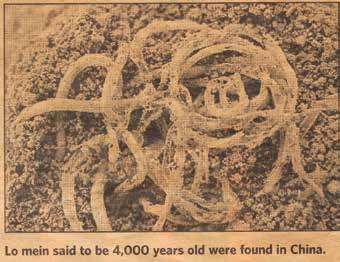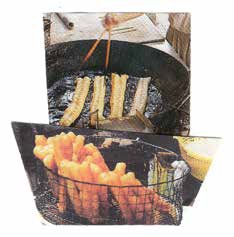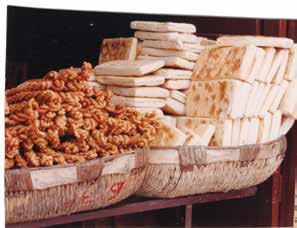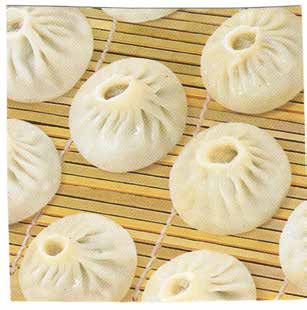
| What is Flavor and Fortune? |
| How do I subscribe? |
| How do I get past issues? |
| How do I advertise? |
| How do I contact the editor? |
Read 12917232 times
Connect me to:
| Home |
| Articles |
| Book reviews |
| Letters to the Editor |
| Newmans News and Notes |
| Recipes |
| Restaurant reviews |
| Article Index (all years, slow) |
| List of Article Years |
| Article Index (2025) |
| Article Index (last 2 years) |
| Things others say |
| Related Links |
| Log In... |
| Authors |
| Categories & Topics |
Staples: Noodles and Other Flour Foods
| by Jacqueline M. Newman |
Rice, Noodles, and Other Grain Foods
Summer Volume: 2019 Issue: 26(2) pages: 12 to 14
Flour, water, a liquid, and salt is all that is needed to make noodles. After making them, knead that dough, then roll it out thick or thin, and cut it into strips wide or narrow. That readers, makes noodles.
If one cuts the rolled out dough into squares or rounds, these can be wrappers for dumplings or other flour-wrapped foods to fill with different minced foods. On them, one can add different sauces and one has different dishes. To the Chinese, noodles or any flour foods are their staples. They are adored most if they are Northern Chinese.

The Qi Min Yao Shu, an agrarian text published in 535 CE, had more than three hundred Chinese recipes in its nine volumes. Many are noodle or other staple dishes, all are sustenance for Chinese, past or present. The ancient Chinese could make them after they could grind a grain or cereal or a dried vegetable including a legume, or another dried food. From these ground items they could make noodles, wrappers, or other dough or staple dishes. In Essential Skills for Everyday Life, its recipes are essential to make many Chinese flour foods. There are new revised editions, perhaps you can find one at www.amazon.com.
Written by a Northern Chinese, this volume, also has recipes for wines, vinegars, soy sauces, sweet dishes, and many main or snack dishes. It was authored by Jai Sixie, and it cites some one hundred and sixty different sources, many earlier books such as the Shi Ci or Gastronomic Procedures>/i>, a fifth century classic of common dishes whose original sources can not be located. They may have been southern Chinese foods handed down since Han Dynasty times, dairy foods, breads, rice, or rice and flour preparations, or other foods popular in China’s earlier days. As all have not been found, that’s a guess, of course.
In 1020 CE, thanks to an Imperial order, a wood block edition was prepared during the early Song Dynasty (960 - 1279 CE). We think there are some twenty other editions published, three in the 1950s by Donald Harper, a professor of Asian languages at Maine’s Bowdoin College. He put out one in English derived from earlier ones including a Chinese one produced by Miu Qiyu, an undated one in Chinese by Shi Sheng-han, one published in 1957, and another done in Japanese by Nishiyama Buichi and Kamashiro Yukio. If you find or have any of them, you have a treasure. We did see a composite edition, but had to return it to the generous friend who loaned it to us.
Steamed bread is part of China’s early cookery; and in these books, the loaves are made with rice, millet, and wheat flours with or without another grain, some with bean flours or a combination thereof. The Chinese were and still are great borrowers and did use many different flours. In this and other books, they placed bread and noodle dishes together whether steamed, boiled, baked, or fried. Breads could be made in metal pans they called ovens, but an oven was not among them.
The noodles found in Lajia, seen on this page in this old picture, is from a 2005 newspaper that says they say they were made four thousand years ago. Found in our mail box, we share this newspaper clipping someone sent us. Known as la mian, they could have been pulled or stretched by hand, then shaped in wooden molds or just dried as seen, then probably baked in an oven or put on a metal or ceramic item with heat coming from a fire below.
Some breads or noodles were called ‘cakes’ long ago, others made with eggs plain or poached in oil were called ‘wine puffs.’ We once read about one stuffed with a walnut and red paste and called hun dun, and shaped like a half moon. Some were steamed and filled with one to four different minced ingredients, still popular today as are dim sum made that way. Those and others have ancestors the Chinese now call jiao zi; though their forerunners may have had various names. Now, they can be pan-fried, steamed, and an interesting one we read about but never saw, was a wheat-grain bread started with fermented simmered rice, sort of a congee made with leavened dough that said it used twice as much leavening in winter than in warmer weather.

We have heard about ancient recipes advising to make Fire-baked Bread, Bone Marrow Bread, and Chinese Doughnuts called ‘loops,’ and ‘lard rings.’ Some were puffs, water-pulled or hand-stretched noodles, extruded noodles, etc. A few recipes were translated by a Chinese friend, and from her, we learned that won meant clouds and ton meant to swallow, so now we understand why some call them ‘swallowing clouds’.

We know that noodles did travel from Fujian to Southeast Asia, rice flour ones moved across Eurasia to Italy, instant noodles came from Japan, and many other flour foods traveled to many other places. Filament noodles were known in Italy long before Marco Polo returned home, and that information comes from archives in Genoa where a basket of macheroni was reported bequeathed to a relative in 1279. Another friend, an Italian, found this information in an Italian Spaghetti Museum. She told us they were made using ground sago palm flour, and that she saw lagana that did originate in ancient Greece made of flour and oil. To the best of our knowledge, only the Chinese, used gluten as a meat replacement isolating this protein as early as 5oo BCE. This museum has many fascinating bits of information.
Marco Polo reports religious abstinence by practitioners who ate nothing but what they called ‘semoa and bran’ as accepted grains outside of Buddhist circles; fried, pickled, shredded, or prepared in other ways or blended with other ingredients. Early on, the Chinese did make foods into mock abalone, mock shrimp, mock chicken, etc. These days we see these foods gaining in popularity in many Chinese markets.
We know that dried wheat flour noodles are northern Chinese staples used for hundreds of years. Today, many are bought in nests, called mien, dan mien, dan mian, or dozens of other names, and used in soups and stir-fries. One chap said they were always dried, but he had no idea who in China or when they were first made. The Chinese used them in many ways; we do, too.
E-fu noodles use wheat flour and were invented in the 18th century. The ones we buy come packed as two noodle circles and in a box showing them off through cellophane windows. We know they are fried, then dried before packaging. Most need boiling for two minutes before eating them. Some are made with eggs, and after frying then drying them, are almost always sold in rounds, often called ‘noodle cakes’.
Flavored noodles can be made with wheat flour, with or without eggs, Some are flavored with real ingredients such as shrimp or crab, others with artificial ones. In the US, the latter need labeling as ‘imitation’ this or that, and most taste of shrimp, crab, fish, or chicken, as their label says. They are made in a myriad of ways no matter their flavor, are always dried, then fried, then dried again. All are popular, and very easy to cook.
Rice sticks, also called rice vermicelli, are made with rice and not wheat flour, are usually lighter in weight and color than if made with wheat flour. They can be less substantial than those made with wheat. Those made in China are not as white nor as light as those made elsewhere. Many are thin and brittle; some wiry, some flat or fat, others are not. Bean thread noodles can have the same names, be semi-transparent, and often are thin. We prefer them soaked before cooking, many made with mung bean starch, and these often turn clear and glass-like when cooked. They have many different names including bean thread, cellophane noodle, glass noodle, silver noodle, transparent noodle, etc. They are popular in soups and stir-fried dishes, and they can squeak or crunch when consumed.

Some are made with sweet potato flour or a mix of sweet potato and mung bean flours. Usually fatter and not always clear, they can be more chewy than those only with mung bean flour. All are delicious, most are popular, and easy to find. All can be purchased in New York City’s Chinatown at a market known as Kam Man Foods. This multi-level place has a large selection to choose from; is at 200 Canal Street, the phone is (212) 571-0330, the fax is (212) 766-9085. One can e-mail or contact them at www.kammanfood.com and one needs to know they ship some but not all refrigerated and fresh noodles.
For those wanting to make any noodle recipes that follow or are found elsewhere, almost all can be made with any combination of noodle products; but it is best to use different kinds cooked separately, then combined before adding any sauce. The amount of water and cooking time can vary, so if using more than one type or thickness, do cook them separately. We always do, then combine them at the last moment. Below are several of our favorites. We hope you enjoy them all.
| E-Fu Noodles, Clams and Black Beans |
|---|
3 Tablespoons oyster sauce
1. Mix oyster and soy sauces, mashed black beans,
chicken stock, sugar, and wine, and set this aside.
|
| Sweet Potato Noodles with Chicken |
|---|
½ each, red and green peppers, seeded and thinly sliced
1. Mix pepper and cucumber pieces with chili and
cucumber pastes and the tea and vinegar
|

Copyright © 1994-2025 by ISACC, all rights reserved
Address
3 Jefferson Ferry Drive
S. Setauket NY 11720